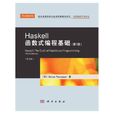《Haskell函式式編程基礎》是2013年科學出版社出版的圖書,作者是Simon Thompson。
基本介紹
- 書名:Haskell函式式編程基礎
- 作者:Simon Thompson
- ISBN:9787030379375
- 頁數:585
- 定價:129.00
- 出版社:科學出版社
- 出版時間:2013-7-1
- 裝幀:平裝
內容簡介
編輯推薦
目錄
1 Introducing funchonal programming
1.1 Computers and modelling
1.2 What is a function?
1.3 Pictures and functions
1.4 Types
1.5 The Haskell programming language
1.6 Expressions and evaluation
1.7 Definitions
1.8 Function definitions
1.9 Types and functional programming
1.10 Calculation and evaluation
1.11 Theessence of Haskell programming
1.12 Domain-specific languages
1.13 Two models of Pictures
1.14 Tests, properties and proofs
2 Getting started with Haskell and GHCi
2.1 A first Haskell program
2.2 Using Haskell in practice
2.3 Using GHCi
2.4 The standard prelude and the Haskell libraries
2.5 Modules
2.6 A second example: pictures
2.7 Errors and error messages
3 Basic types and definitions
3.1 The Booleans: Bool
3.2 The integers: Integer and Int
3.3 Overloading
3.4 Guards
3.5 Characters and strings
3.6 Floating-point numbers: Float
3.7 Syntax
4 Designing and writing programs
4.1 Where do I startl Designing a program in Haskell
4.2 Solving a problem in steps: local definitions
4.3 Defining types for ourselves: enumerated types
4.4 Recursion
4.5 Primitive recursion in practice
4.6 Extended exercise: pictures
4.7 General forms of recursion
4.8 Program testing
5 Data types, tuples and lists
5.1 Introducing tuples and lists
5.2 Tuple types
5.3 Introducing algebraic types
5.4 Our approach to lists
5.5 Lists in Haskell
5.6 List comprehensions
5.7 A library database
6 Programnung with lists
6.1 Generic functions: polymorphism
6.2 Haskell list functions in the Prelude
6.3 Finding your way around the Haskell libraries
6.4 The Picture example: implementation
6.5 Extended exercise: alternative implementations of pictures
6.6 Extended exercise: positioned pictures
6.7 Extended exercise: supermarket billing
6.8 Extended exercise: cards and card games
7 Defining functions over lists
7.1 Pattern matching revisited
7.2 Lists and list patterns
7.3 Primitive recursion over lists
7.4 Finding primitive recursive definitions
7.5 General recursions over lists
7.6 Example: text processing
8 Playing the game: I/O in Haskell
8.1 Rock-Paper-Scissors: strategies
8.2 Why is I/O an issue?
8.3 The basics of input/output
8.4 The do notation
8.5 Loops and recursion
8.6 Rock-Paper-Scissors: playing the game
9 Reasoning about programs
9.1 Understanding definitions
9.2 Testing and proof
9.3 Definedness, ternunation/and finiteness
9.4 A little logic
9.5 Induction
9.6 Further examples of proofs by induction
9.7 Generalizing the proof goal
10 Generalization: patterns of computation
10.1 Patterns of computation over lists
10.2 Higher-order functions:functions as arguments
10.3 Folding and primitive recursion
10.4 Generalizing: splitting up lists
10.5 Case studies revisited
11 Higher-order functions
11.1 Operators: function composition and application
11.2 Expressions for functions:lambda abstractions
11.3 Partial application
11.4 Under the hood: curried functions
11.5 Defining higher-order functions
11.6 Verification and general functions
12 Developing higher-order programs
12.1 Revisiting the Picture example
12.2 Functions as data: strategy combinators
12.3 Functions as data: recognizing regular expressions
12.4 Case studies: functions as data
12.5 Example: creating an index
12.6 Development in practice
12.7 Understanding programs
13 Overloading, type classes and type checking
13.1 Why overloading?
13.2 Introducing classes
13.3 Signatures and instances
13.4 A tour of the built-in Haskell classes
13.5 Type checking and type inference: an overview
13.6 Monomorphic type checking
13.7 Polymorphic type checking
13.8 Type checking and classes
14 Algebraic types
14.1 Algebraic type definitions revisited
14.2 Recursive algebraic types
14.3 Polymorphic algebraic types
14.4 Modelling program errors
14.5 Design with algebraic data types
14.6 Algebraic types and type classes
14.7 Reasoning about algebraic types
15 Case study: Huffman codes
15.1 Modules in Haskell
15.2 Modular design
15.3 Codingand decoding
15.4 Implementation-Ⅰ
15.5 Building Huffman trees
15.6 Design
15.7 Implementation-Ⅱ
16 Abstract data types
16.1 Type representations
16.2 The Haskell abstract data type mechanism
16.3 Queues
16.4 Design
16.5 Simulation
16.6 Implementing the simulation
16.7 Search trees
16.8 Sets
16.9 Relations and graphs
16.10 Commentary
17 Lazy programming
17.1 Lazy evaluation
17.2 Calculation rules and lazy evaluation
17.3 List comprehensions revisited
17.4 Data-directed programming
17.5 Case study: parsing expressions
17.6 Infinite lists
17.7 Why infinite lists?
17.8 Case study:simulation
17.9 Ptoof revisited
18 Programnung with monads
18.1 I/O programming
18.2 Further I/O
18.3 The calculator
18.4 The do notation revisited
18.5 Monads:languages for functional programming
18.6 Example: monadic computation over trees
……
19 Domain-specific languages
20 Time and space behaviour
21 Conclusion
Appendices
A Functional,imperative and OO programming
B Glossary
C Haskell operators
D Haskell practicalities
E GHCi errors
F Project ideas
Bibliography
Index

